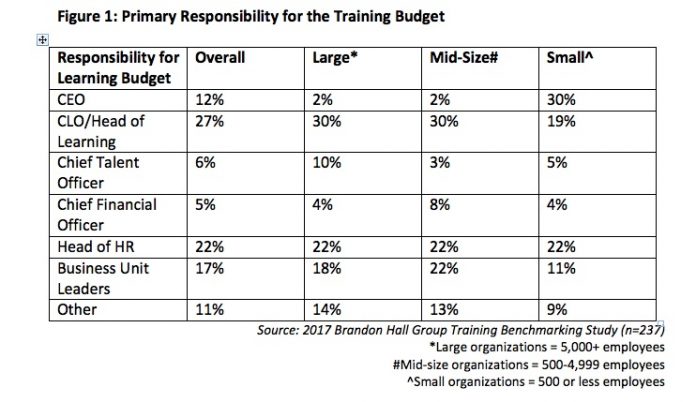
Training is often one of an organization’s biggest budget line items. With business needs changing quickly and technology advancing even faster, companies are constantly reevaluating how they spend their training dollars. It also can be difficult to determine just how big the Training function should be related to a company’s size and the industry in which they operate.
According to Brandon Hall Group’s 2017 Training Benchmarking Study, actual budget sizes vary widely and depend on numerous factors, the most influential being the sheer size of the organization. Average budget by company size are:
- Large organizations (5,000-plus employees): $25.8 million
- Mid-size organizations (500-4,999 employees): $1.1 million
- Small organizations (Less than 500 employees): $300,000
The data also shows that learning budgets are almost as likely to decrease (24 percent) as increase (26 percent), and that half of budgets will remain the same. Therefore, Learning leaders need to take a hard look at how they are spending their dollars and perhaps make some innovative choices to make the most of what they have.
For instance, when an e-learning course costs more than twice as much to produce as a learning game, but is rated only 11 percent more effective, it might make sense to reconsider priorities.
In many organizations, learning isn’t even in control of the budget. It is often in the hands of executives, business leaders, or even finance—groups that will expect a stronger demonstration of learning’s impact than learning typically expects from itself. Unfortunately, the traditional ways learning has been executed have not necessarily delivered the desired results. It should not be surprising, then, that the training purse strings remain tight.
The good news is that as learning has evolved, there is evidence that newer modalities and technologies are delivering good results for less cost. The research found that classroom experiences and e-learning courses are the most expensive to create, but not necessarily the most effective learning modalities.
High-performance organizations are taking advantage of this to a far greater extent than other companies. They are far more likely to leverage modalities such as videos, social/collaboration tools, mobile learning, and games as part of their learning strategy.
By focusing on approaches that are both effective and cost less, these Learning functions can drive results and increase the return their organizations are getting for their learning investment.
Here is some further analysis of four significant findings.
Learning Is Often Not in Charge of the Learning Budget
It would seem obvious that the head of the Learning function ultimately would be responsible for the training budget. But many organizations do not have a Learning function, let alone a head of Learning. At about three-quarters of organizations, training is carried out as a function of another group altogether, such as HR. In organizations with fewer than 500 employees, the CEO is most likely to oversee the learning budget. Even at large organizations (5,000-plus employees), the learning budget is controlled by the head of Learning, HR, or Talent in only 62 percent of organizations.
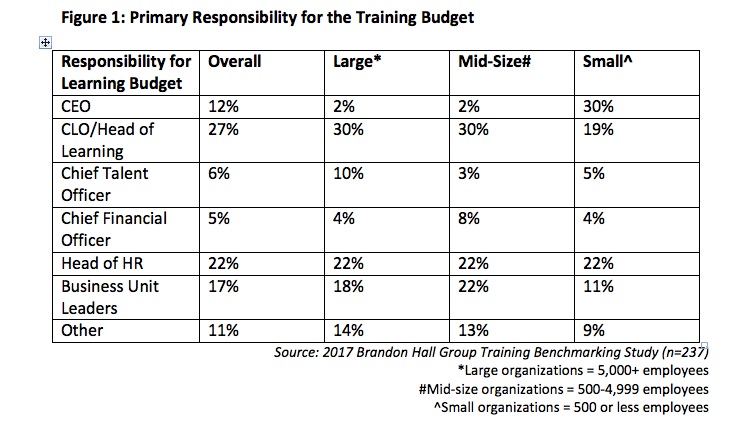
Training budget development is important because the party responsible for developing the budget has a huge impact on how it is allocated. A CEO or chief financial officer may have a much different view of the learning strategy than the head of HR or Learning, for instance.
It is critical that whoever is ultimately responsible for the learning budget gets input from all parts of the business so that whatever scarce money is reserved for learning is allocated in the most strategic, effective ways. The more learning is tied to business goals and outcomes, the more value it will have to the decision-makers outside of Learning who control the purse strings.
New Learning Modalities Can Lead to Big Savings
A traditional measurement of training has been the amount it costs to develop one hour of training. But we live in an environment where learning is not delivered in hours, but in experiences. These experiences vary widely—multiple days for an in-person instructor-led training (ILT) program, several hours for an e-learning course, and mere minutes for a video.
To better reflect this model, our study asked organizations how many hours it takes to create a given experience. We then can multiply that by the hourly cost of creating training to get an idea of what it costs to create various learning experiences. The study found that the average hourly cost to devlop any kind of training is about $317. This includes headcount, technology, external resources, and anything else required to create the experience.
An e-learning course ends up being the most expensive asset to create, requiring an average of 85 hours to put together, which results in an average cost of $26,818. On the other end of the spectrum, a learning game takes an average of 39 hours to put together, resulting in an overall average cost of $12,363.

High-Performance Organizations Are Seeing the Light
Technology and the evolution of informal and experiential learning have provided more delivery options than ever before. Social media tools, mobile devices, HD video, games and simulations, and much more have greatly expanded the breadth and depth of the learning ecosystem.
Yet these modalities, which organizations rank relatively close to classroom learning in effectiveness, are utilized far less often than classroom learning—even though they are far less expensive.
Despite the high cost, organizations still use in-person, instructor-led classroom training far more often than any other modality. On a five-point rating scale where 1 is 0 percent of total training and 5 is more than 75 percent, instructor-led classroom rates a 3.57, 13 percent more than even e-learning modules, which rated a 3.17.
What’s remarkable about this is that the level of effectiveness of these delivery methods often does not match. While ILT’s effectiveness rating is just slightly less than the use, the effectiveness rating for online games and simulations is twice as high as its use (2.72 vs. 1.31). There are also sizable effectiveness gaps in other newer, less expensive modalities.
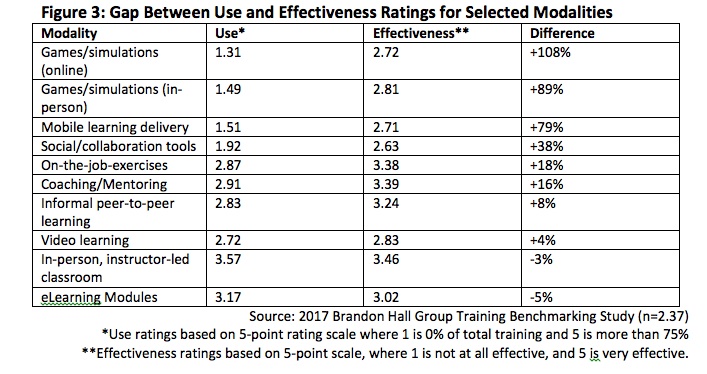
These effectiveness ratings are self-reported and do not reflect the specific metrics for each organization in the study. However, it is telling that modalities such as coaching and mentoring and on-the-job exercises rank almost as high in effectiveness. Informal, peer-to-peer learning also ranks high in effectiveness, especially in contrast to how much organizations rely on it. All of these methods are rated more effective than e-learning, which is the second most common learning modality. Modalities such as in-person games and simulations also score relatively high for effectiveness, yet they are at the bottom for use.
High-performance organizations (HiPOs) are seizing on the opportunity to utilize these new modalities at a much higher rate than other organizations. HiPOs are those employers whose key performance indicators are moving in a positive direction year over year. The data below shows the percentage of companies using these modalities for more than half of their learning initiatives.
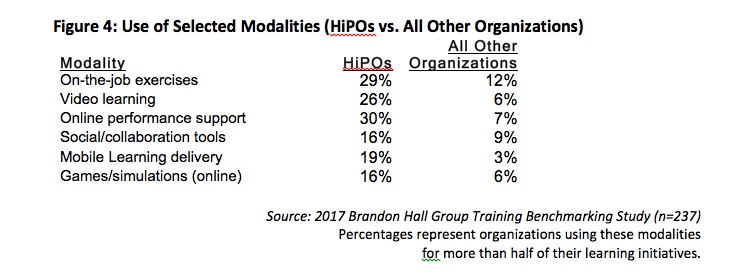
The differences are stark. In each case, HiPOs are more likely to use these modalities for a majority of their learning by at a least a factor of two. The bottom line is that organizations are discovering there are many more effective methods available to them. But even among HiPOs, less than one-third have broken out of the formal classroom/e-learning model enough to take advantage of them.
Training Investment Follows Hierarchy
Overall, organizations tend to use a “trickle-down” approach when they leverage their training dollars. When we look at per-learner training budgets, we see that companies clearly are spending more money at the top, and spending correspondingly less as they move down the hierarchy.
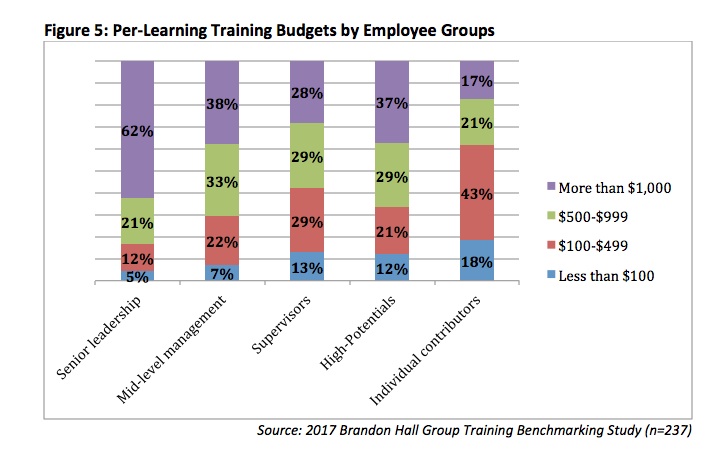
The biggest budget band for senior leadership is more than $1,000 per learner per year, with 62 percent of companies spending that much. Only 17 percent spend that much annually per individual contributor. There are always going to be more individual contributors within an organization than senior leaders, but the disparity between the spending amounts is significant. But training for any employee group is not necessarily cheap, as few companies spend less than $100 per year for any type of employee.
High-potentials get a decent amount spent on them annually; 37 percent of companies spend $1,000 or more. But that is still a far cry from what gets spent on senior leadership.
Our talent acquisition and talent management research shows that the top corporate priorities are employee experience, employee engagement, and employee retention. Employers need to ask themselves whether the hierarchal approach to their investment in training lines up with those priorities.
Conclusion
The battle for the budget has always been fierce. Learning functions have always been forced to do more with less, and that trend continues. Only 26 percent of companies say their learning budget will increase next year.
The challenge moving forward will be transforming the way learning is delivered by exploring new technologies with a static or even shrinking budget. This is especially critical as companies look for ways to keep learning from interrupting the job. Reducing the costs incurred from travel, lost productivity, and lost opportunities goes a long way to justifying the learning budget.
High-performance companies seem to have recognized this earlier than others and have led the charge in exploring multiple learning experiences. This allows these companies to deliver more strategic, targeted learning, rather than the traditional one-size-fits-all approach of ILT and e-learning. Without this outlook and strategy, companies will continue to deliver training, rather than develop their workforce.
David Wentworth is principal Learning analyst at Brandon Hall Group, an independent research/analyst firm in the Human Capital Management market. The firm’s vision is to inspire a better workplace experience, and its mission is to empower excellence in organizations around the world through its research and tools. Brandon Hall Group has five HCM practices, and produces the Brandon Hall Group Excellence Awards and the annual HCM Excellence Conference, held Jan. 30-Feb. 2, 2018, in Palm Beach Gardens, FL.



